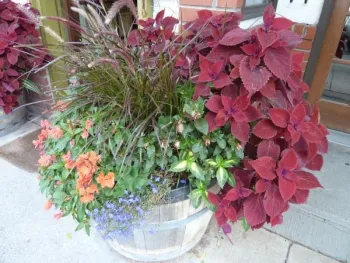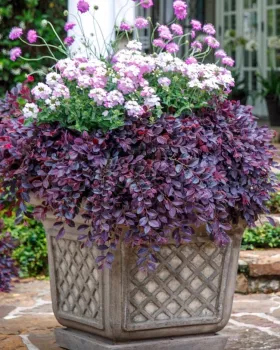
Plants in containers have some special needs besides the light, air, water, and nutrients that all plants need. Container plants also need a good soil mixture, the proper container, fertilizer amendments and attention to water.
Soil Mixture
A container plant needs a more porous soil mixture to thrive and will not do well using ordinary garden soil (especially the Valley's clay soil). Containers have a shallow depth and reduced ability to pull moisture downward. Using ordinary garden soil would result in poor drainage, which can lead to poor growth and root rot. While there are recipes for creating a container soil mixture, the easiest solution on a small scale is to use a good quality commercial potting soil. These mixtures do not contain soil but a mixture of ingredients to improve drainage and aeration, and many are fortified with a fertilizer.
Containers
For flowers, you want containers that are pleasing and go well with the color of the plants, but the container needs other qualities for healthy plants. A container should have adequate drainage holes. A container without drainage holes can work if you double pot the container, putting plants in a container with drainage holes and placing it on gravel inside a pot without drainage holes. But it is easier to select a pot with drainage holes in the first place.
Container size is important. Outdoor container plants, especially rapidly growing ones like summer annuals, need adequate space for root development. Small pots require more frequent watering and restrict root growth, which results in fewer flowers. Containers should hold several gallons of potting mixture for the most attractive plants and best flowers. Pots are generally sold by diameter, and a 12-14” diameter pot is usually an adequate size for flowers.
A variety of container materials work well—terra cotta clay (glazed or unglazed), wood, plastic, fiberglass, concrete, even found materials. Use your creativity! Since we live in a mild climate, a cracked or broken clay pot in cold weather is not as much of a danger, but if there's a cold spell, you might want to move clay pots to a sheltered place.

Fertilizer
Each time a container plant is watered, fertilizer is flushed out. If your potting mixture doesn't contain fertilizer, you should add fertilizer at planting, and then fertilize again in two to three weeks. This can be liquid soluble, garden type, or time-release fertilizer. A liquid soluble fertilizer can be applied every two to three weeks according to label directions, enough so that some drains out of the bottom. Garden type fertilizer can be applied every three to four weeks, using ½ teaspoon per gallon, spread evenly on the soil surface and watered. Time release fertilizers are popular and generally last about three months. Apply according to package directions (usually about a teaspoon per gallon of soil) and water in. Some potting soils come with time release fertilizer, so be aware of what you have already used.
Water
Container plants should never be allowed to completely dry out. This damages feeder roots and leads to flower drop. When the plant does get water, its energy goes to regrowing feeder roots, while plant growth and flower production suffer. Plants in smaller and/or darker pots, higher temperatures, higher wind, and in direct sun will require more water. A mature plant is likely to need watering daily in warm weather. If the top 2-3 inches of potting mix is dry, the plant needs water. Overwatering is also detrimental, as the water fills all the pore space, and the plant can't get enough oxygen. Water only when necessary, and water until water starts to come out of the drainage holes.
Design and Potting
Many flowers do well in pots, and nurseries often have “good in containers” on the nursery tags, along with the plant's requirements for sun, water, bloom time, size, etc. Read the labels so you will know what plants grow in what season and be able to pot plants with similar requirements together. I like to choose plants with long displays, so there's overlap in the seasons.

In selecting plants, try to choose ones in top condition. They should be lush on all sides, without empty areas or dead material. Plants should be stocky and sturdy, not spindly. Its roots should not be pushing out of the pot. If you can gently push the plant out of the pot to examine its roots, it should have roots that are tan or white, growing towards the side and bottom of the pot, but not circling it.
A potted container should have a reservoir free of potting soil at the top of the pot, generally the top 1 ½ to 3 inches in a larger pot. When planting a container, the potting mix should be moist but not drenched. Partially fill the pot loosely with potting mix and arrange the plants so that the soil level of the new plants is slightly higher than the potting mix level. Fill in with potting soil around the plants and tap or shake gently to settle the soil. Don't press down the soil, which will compact it. Water thoroughly after planting, which will even the soil level of the new plants with the potting soil.
Most of all, have fun! Keep track of what works and what doesn't, and don't be afraid to give up on a plant that doesn't thrive. We all learn by doing and become better gardeners with knowledge and practice. Spring is a great time to get started!
References:
North Carolina Extension Gardener Handbook: 18. Plants Grown in Containers
Growing Plants in Containers by Oregon State University
Container Gardening: Fresh Ideas for Outdoor Living by the Editors of Sunset Magazine

